This one day workshop was held on the 1st June 2024 with 10 participants attending including Hugh Andrews who submitted this article. There was much praise by all for this event – so much so that they wanted to encourage others to make a note and join when it is offered again! JC
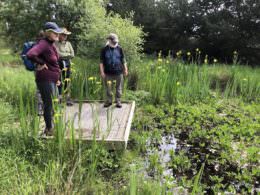 What a wonderful day that was. To be shown around the Findhorn Hinterland by Alan Watson Featherstone and Heather Paul. Two true experts in their fields of biodiversity and lichens, who for the decade and more have poured their love and passion into the land, studying the amazing array of different species of plants and animals that live here. Their particular love is for the micro worlds of invertebrates, lichens and fungi, that most of us walk past without a glance. Our day was a real treat opening us up to these hidden gems. There are literally hundreds of different species of bugs, beetles, spiders, aphids and other insects here, along with hundreds of different lichens, fungi and slime moulds that have so far been recorded here, some of which are extremely rare.
What a wonderful day that was. To be shown around the Findhorn Hinterland by Alan Watson Featherstone and Heather Paul. Two true experts in their fields of biodiversity and lichens, who for the decade and more have poured their love and passion into the land, studying the amazing array of different species of plants and animals that live here. Their particular love is for the micro worlds of invertebrates, lichens and fungi, that most of us walk past without a glance. Our day was a real treat opening us up to these hidden gems. There are literally hundreds of different species of bugs, beetles, spiders, aphids and other insects here, along with hundreds of different lichens, fungi and slime moulds that have so far been recorded here, some of which are extremely rare.
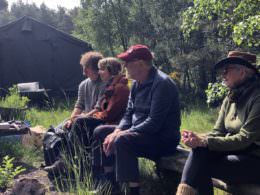 The day started off with a general discussion of the Hinterland Trust’s work and aims in maintaining and enhancing the existing four main habitats that are found here – woodland, species rich grassland, heathland and dune scrub. Each area has very distinct and different species associated with it. We were given a small hand lens with a x10 magnification, needed to open us up to the “Alice in Wonderland” world of the micro. Splitting us up into two small groups we went off on our adventure into this new world, one half going with Alan and the other with Heather. This allowed an intimacy where we could really study in detail the features that were being pointed out.
The day started off with a general discussion of the Hinterland Trust’s work and aims in maintaining and enhancing the existing four main habitats that are found here – woodland, species rich grassland, heathland and dune scrub. Each area has very distinct and different species associated with it. We were given a small hand lens with a x10 magnification, needed to open us up to the “Alice in Wonderland” world of the micro. Splitting us up into two small groups we went off on our adventure into this new world, one half going with Alan and the other with Heather. This allowed an intimacy where we could really study in detail the features that were being pointed out.
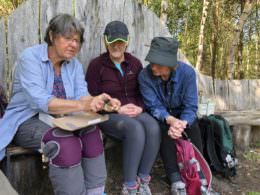 Alan took us for a journey through the trees, showing how small pockets of the original pine plantation have been opened up and new native broadleaves introduced. These greatly enhance the variety of creatures that now live here, pointing out shield bugs, and spiders living in the leaves, along with the leaf miners living in the leaves. Picking an old pine cone from a tree, Alan tapped it into his palm to show us the pine seeds. But instead of seeds falling out, spiders, mites and aphids appeared, showing how a cone was a complete habitat in its own right.
Alan took us for a journey through the trees, showing how small pockets of the original pine plantation have been opened up and new native broadleaves introduced. These greatly enhance the variety of creatures that now live here, pointing out shield bugs, and spiders living in the leaves, along with the leaf miners living in the leaves. Picking an old pine cone from a tree, Alan tapped it into his palm to show us the pine seeds. But instead of seeds falling out, spiders, mites and aphids appeared, showing how a cone was a complete habitat in its own right.
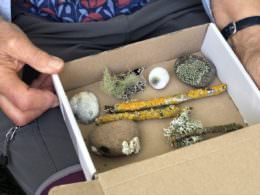 Then it was Heather’s turn to enrapture us, as we peered into the world of lichens. What amazing patterns and colours leapt out at us as we studied a pebble or piece of bark through our hand lens. She shared how some of the species, particularly those on the sand and heathland here are extremely rare. One of the main aims of the Hinterland Trust is to try and support these species, and the only way to do that is by removing trees and gorse that are rapidly moving into the dune area. Removing trees can seem at odds with nature conservation, but in this case it is vitally necessary if the overall biodiversity is to be maintained.
Then it was Heather’s turn to enrapture us, as we peered into the world of lichens. What amazing patterns and colours leapt out at us as we studied a pebble or piece of bark through our hand lens. She shared how some of the species, particularly those on the sand and heathland here are extremely rare. One of the main aims of the Hinterland Trust is to try and support these species, and the only way to do that is by removing trees and gorse that are rapidly moving into the dune area. Removing trees can seem at odds with nature conservation, but in this case it is vitally necessary if the overall biodiversity is to be maintained.
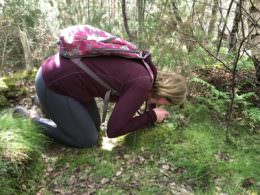 So we returned to base with big smiles on our faces, nurtured by a glorious day of sunshine, knowledge, beauty and friendship, and now looking forward to each buying our own hand lens, so we can continue to explore this magical world that is literally under our feet and all around us.
So we returned to base with big smiles on our faces, nurtured by a glorious day of sunshine, knowledge, beauty and friendship, and now looking forward to each buying our own hand lens, so we can continue to explore this magical world that is literally under our feet and all around us.
Hugh Andrews
FHT Member
June 2024



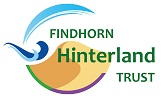
Findhorn Hinterland Biodiversity Workshop
This one day workshop was held on the 1st June 2024 with 10 participants attending including Hugh Andrews who submitted this article. There was much praise by all for this event – so much so that they wanted to encourage others to make a note and join when it is offered again! JC
Hugh Andrews
FHT Member
June 2024